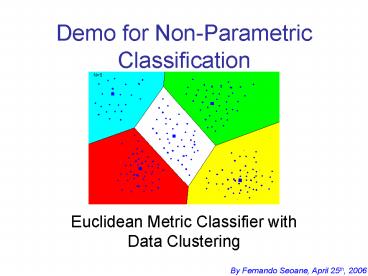Demo for Non-Parametric Classification PowerPoint PPT Presentation
Title: Demo for Non-Parametric Classification
1
Demo for Non-Parametric Classification
- Euclidean Metric Classifier with Data Clustering
2
Data Classification by Similarity
- The similarities among the data is the basis of
this type of classification - Similar data is classified together
- Similar term in the mathematical sense, it must
be mathematically defined - In the metric Space
- Euclidean Distance, Manhattan distance, etc
- Nearest-Neighbor approach
3
Classification Method
- Steps
- A priori information. Classified Observations
- Model Reduction to reduce computation.
- Use of nearest-neighbor approach.
- A cluster point represents a group of neighbor
data points. Voronoid Tesselation - Selection of no. of Cluster centers is
important. - The unclassified measurements are evaluation
against the clusters points. - K-nearest neighbor rule is applied for Euclidean
distance and k 1
Training data Class a
Training data Class b
Cluster Partitioning
Cluster Centers a
Cluster Centers b
Unclassified data
Neighbor Evaluation Minimum distance
Data classified as Class a
Data classified as Class b
4
K-means and K-medoid algorithms
5
Feature Space for Training Observations
6
Kmedoid Function
- Syntax
- resultKmedoid(data.X,param.c)
- Function
- The objective function Kmedoid algorithm is to
partition the data set X into c clusters - Result
- The calculated cluster center vi (i ? 1,
2,..c) is the nearest data point to the mean of
the data points in cluster i.
7
Cluster Partition for Case a
8
Cluster Partition for Case b
9
Cluster Partition all Cases
10
New Observations in the Feature Space
11
New Observations Classified
12
Improvements and Suggestions
- To Validate the cluster perfomance classifying
the a priori training data - To test the effect on the clusters perfomance the
no. of cluster protoypes - To try classification using the complete training
data, without Cluster partitioning - To Increase K in the nearest neighbor selection
13
The End
Thank You!
PowerShow.com is a leading presentation sharing website. It has millions of presentations already uploaded and available with 1,000s more being uploaded by its users every day. Whatever your area of interest, here you’ll be able to find and view presentations you’ll love and possibly download. And, best of all, it is completely free and easy to use.
You might even have a presentation you’d like to share with others. If so, just upload it to PowerShow.com. We’ll convert it to an HTML5 slideshow that includes all the media types you’ve already added: audio, video, music, pictures, animations and transition effects. Then you can share it with your target audience as well as PowerShow.com’s millions of monthly visitors. And, again, it’s all free.
About the Developers
PowerShow.com is brought to you by CrystalGraphics, the award-winning developer and market-leading publisher of rich-media enhancement products for presentations. Our product offerings include millions of PowerPoint templates, diagrams, animated 3D characters and more.

